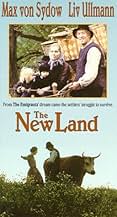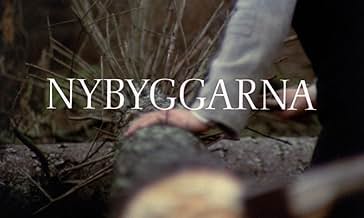CALIFICACIÓN DE IMDb
8.0/10
5.6 k
TU CALIFICACIÓN
Agrega una trama en tu idiomaA Swedish immigrant family struggle to establish a new life for themselves in 1850s Minnesota.A Swedish immigrant family struggle to establish a new life for themselves in 1850s Minnesota.A Swedish immigrant family struggle to establish a new life for themselves in 1850s Minnesota.
- Dirección
- Guionistas
- Elenco
- Nominado a 1 premio Óscar
- 9 premios ganados y 1 nominación en total
Karin Nordström
- Judit, hans hustru
- (as Karin Nordström-Järegård)
- Dirección
- Guionistas
- Todo el elenco y el equipo
- Producción, taquilla y más en IMDbPro
Opiniones destacadas
In 2016 after years of waiting, Criterion Collection has released this two-part epic in Blu-Ray and standard DVD. For fullest effect, the two segments should be played as in the original, theatrical release: "The Emigrants" entirely in Swedish (with English subtitles), "The New Land" in English. It is in itself quite an achievement that the cast of both is virtually identical yet are competent in the new and old languages. Scandinavian immigrants to the Minnesota Territory in the 1850's--before the US Civil War-- found conditions both familiar and alien. The cold climate was like their native land but the soil of the New World was more fertile and not so stony. It was a place of open spaces and vast pine forests, few towns and no cities to compare with Stockholm or Oslo.
In the story, friendships are tested, some broken over issues of religion. Family life isn't always smooth or predictable. There are generational conflicts. Historical events are alluded to such as the Civil War or depicted, if briefly, like the 1862 uprising of the Eastern Sioux, starving on their Minnesota reservation, with deadly attacks on surrounding settlements until put down by the US Army. Yet the Indian side of the conflict is given play, also, with the emigrants coming to understand that The New Land had belonged to others before them.
In the story, friendships are tested, some broken over issues of religion. Family life isn't always smooth or predictable. There are generational conflicts. Historical events are alluded to such as the Civil War or depicted, if briefly, like the 1862 uprising of the Eastern Sioux, starving on their Minnesota reservation, with deadly attacks on surrounding settlements until put down by the US Army. Yet the Indian side of the conflict is given play, also, with the emigrants coming to understand that The New Land had belonged to others before them.
"The New Land" is the second half of a story started in Troell's "The Emigrants," which depicted the struggles of a band of Swedish peasants in their move to America. Here, several of the settlers- such as the priest and the prostitute- move away in the first half-hour and reappear here and there throughout the rest of the film. The plot focuses on Karl-Oscar, his wife Kristina, and the family they try to raise in the Minnesota wilderness.
Von Sydow and Ullmann are given a chance to embellish on their characters, and they both do excellent work. Axberg also does a fine job of lending more depth to the character of Robert, Karl-Oscar's rebellious younger brother. There is also material worked in that examines the mistreatment (and eventual uprising) of local Native Americans and the futile searches for gold in the north. These other elements do not always seem to fit with the central story, but they effectively add to the sense of time and place anyway.
"The New Land" does not have the same emotional impact that "The Emigrants" had, but it develops the two central characters more and intelligently explores how they learn to adapt to their new life. Put together, these two films convincingly illustrate the plight of those who forged our frontier.
Von Sydow and Ullmann are given a chance to embellish on their characters, and they both do excellent work. Axberg also does a fine job of lending more depth to the character of Robert, Karl-Oscar's rebellious younger brother. There is also material worked in that examines the mistreatment (and eventual uprising) of local Native Americans and the futile searches for gold in the north. These other elements do not always seem to fit with the central story, but they effectively add to the sense of time and place anyway.
"The New Land" does not have the same emotional impact that "The Emigrants" had, but it develops the two central characters more and intelligently explores how they learn to adapt to their new life. Put together, these two films convincingly illustrate the plight of those who forged our frontier.
"The New Land" is the second half of a story started in Troell's "The Emigrants," which depicted the struggles of a band of Swedish peasants in their move to America. Here, several of the settlers- such as the priest and the prostitute- move away in the first half-hour and reappear here and there throughout the rest of the film. The plot focuses on Karl-Oscar, his wife Kristina, and the family they try to raise in the Minnesota wilderness.
Von Sydow and Ullmann are given a chance to embellish on their characters, and they both do excellent work. Axberg also does a fine job of lending more depth to the character of Robert, Karl-Oscar's rebellious younger brother. There is also material worked in that examines the mistreatment (and eventual uprising) of local Native Americans and the futile searches for gold in the north. These other elements do not always seem to fit with the central story, but they effectively add to the sense of time and place anyway.
"The New Land" does not have the same emotional impact that "The Emigrants" had, but it develops the two central characters more and intelligently explores how they learn to adapt to their new life. Put together, these two films convincingly illustrate the plight of those who forged our frontier.
Von Sydow and Ullmann are given a chance to embellish on their characters, and they both do excellent work. Axberg also does a fine job of lending more depth to the character of Robert, Karl-Oscar's rebellious younger brother. There is also material worked in that examines the mistreatment (and eventual uprising) of local Native Americans and the futile searches for gold in the north. These other elements do not always seem to fit with the central story, but they effectively add to the sense of time and place anyway.
"The New Land" does not have the same emotional impact that "The Emigrants" had, but it develops the two central characters more and intelligently explores how they learn to adapt to their new life. Put together, these two films convincingly illustrate the plight of those who forged our frontier.
I watched this the day after watching The Emigrants. They're really one film cut into two very long halves. I suppose Kill Bill 2 also is a standalone movie, but no one would recommend seeing only that and not watching Kill Bill 1. It's the same for The Emigrants and The New Land. Certain relationships in this movie only have power because of the backstory found in The Emigrants, such as Robert and Arvid's close friendship, why Kristina is so attached to Kristina despite religious differences, and even why Uncle Danjel is relevant.
The cinematography in this film felt more jarring and experimental, particularly with respect to Robert's trip out west. The movie is incredibly long and drawn out, and the timeline can be hard to pinpoint. An hour may be spent on days or weeks and then years suddenly pass between camera cuts.
This film does excel at showing both the impact of loss and how commonplace death was on the frontier. Danger never was far away, and seemingly distant occurrences suddenly could have local impact, whether the Civil War or strife with the Indian tribes. The New Land a pretty good film, but it suffers even more so than The Emigrants from overlength and without quite as much punch.
The cinematography in this film felt more jarring and experimental, particularly with respect to Robert's trip out west. The movie is incredibly long and drawn out, and the timeline can be hard to pinpoint. An hour may be spent on days or weeks and then years suddenly pass between camera cuts.
This film does excel at showing both the impact of loss and how commonplace death was on the frontier. Danger never was far away, and seemingly distant occurrences suddenly could have local impact, whether the Civil War or strife with the Indian tribes. The New Land a pretty good film, but it suffers even more so than The Emigrants from overlength and without quite as much punch.
¿Sabías que…?
- TriviaThe movie and its prequel Los emigrantes (1971) were Oscar nominated on the same year (1972), though in different categories. This is the first and only occurrence of such an event.
- ErroresIn one of the first scenes, when Karl Oskar is taking the family to the new settlement, the boom mic is visible in the upper left corner for the entire shot.
- Citas
Karl-Oskar: Kristina, do you remember when we moved here last fall, you said it was almost as pretty as back home in Duvemåla? Maybe we could call our home here Duvemåla. What do you say to that? Or New Duvemåla.
Kristina: Just think, that I - Duvemåla.
Karl-Oskar: Yeah.
Kristina: Then we don't live at Ki-Chi-Saga any more. We live at Duvemåla.
- Versiones alternativasThe USA television version, called "The Emigrant Saga" consists of this film plus its prequel, Los emigrantes (1971), joined and re-edited together in chronological order and dubbed in English.
- ConexionesFeatured in Stjärnbilder (1996)
Selecciones populares
Inicia sesión para calificar y agrega a la lista de videos para obtener recomendaciones personalizadas
- How long is The New Land?Con tecnología de Alexa
Detalles
Contribuir a esta página
Sugiere una edición o agrega el contenido que falta

Principales brechas de datos
By what name was Nybyggarna (1972) officially released in India in English?
Responda






























